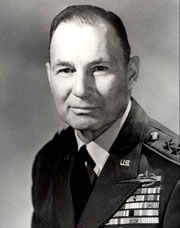Lloyd Roosevelt Moses was born on September 4, 1904 to James H. Moses and Alice O. Shelden in Fairfax, South Dakota. Alice Shelden was of Sioux heritage. Moses attended White Thunder Indian Day School in Mellette County and Colome High School, in Colome, South Dakota.
From 1925-1927, Moses was a rural schoolteacher for the Rosebud School District and later he was the Deputy County Superintendent of Schools. He then studied Chemistry at the University of South Dakota from 1927-1931. He was a member of the USD ROTC and received a commission of Lieutenant in the Army Reserve. It was also at USD where he met his wife, Ruth West. They were married on February 14, 1935.
In 1932, Moses was employed as an instructor of Chemistry at Sioux Falls College and he also worked for the Witte Paint and Chemical Company. Moses served in the Army Reserves until 1940. One of his tours of duty included working with the Civilian Conservation Corps (CCC) in Breckenridge, Minnesota. In 1940, he was called into active duty. Moses trained soldiers in Missouri and Alabama until 1945 when he was sent to Europe to serve with the 507th Parachute Regiment. He worked on the European theater staff and was included in the airborne assault over the Rhine.
At the end of World War II (1939-1945), he became post commander at Sendai, Japan.
Moses was once more in combat while commanding the 31st Infantry Regiment during the Korean War (1950-1953). He served again in Japan from 1953-1954 and then returned to the United States to serve at Fort Leavenworth and Fort Dix.
In 1957, he was assigned to the Southern Area Command in Munich, Germany. Moses commanded the 8th Infantry Division from 1959-1960 and U.S. Fifth Army (1960-1964). He retired from the Army as a Major General in 1964 and settled in Vermillion, South Dakota.
After retirement, Moses served as the director of Institute of Indian Studies (the current Institute for American Indian Studies) at the University of South Dakota from 1967-1974. He was instrumental in developing Indian related Courses at USD and overhauling the direction and purpose of the Institute. Moses was active with the South Dakota State and the Clay County Historical Societies. He was an avid sportsman, writer and historian. He was also involved with publishing several books including his autobiography Whatever it Takes, Who’s Who Among the Sioux (written with T. Emogene Paulson), and Paulson’s Sioux Collections. Moses was a member of the Rosebud Sioux Tribe and he was given the Indian name of Tokaha Waste Wicasha (good leader).
Moses died on August 22, 2000. Moses and his wife are buried in Arlington National Cemetery, Washington, D.C. Section 68, Grave 2811.
MOSES, LLOYD R
- MAJ GEN US ARMY
- VETERAN SERVICE DATES: 01/01/1935 – 09/30/1964
- DATE OF BIRTH: 09/30/1904
- DATE OF DEATH: 08/27/2000
- DATE OF INTERMENT: 09/12/2000
- BURIED AT: SECTION 68 SITE 2811
ARLINGTON NATIONAL CEMETERY
MOSES, RUTH M
- DATE OF BIRTH: 03/17/1905
- DATE OF DEATH: 11/09/1991
- DATE OF INTERMENT: 06/23/1999
- BURIED AT: SECTION 68 SITE 2811
ARLINGTON NATIONAL CEMETERY - WIFE OF MOSES, LLOYD R MAJ GEN US ARMY
Major General Lloyd R. Moses, DSC, received the Distinguished Service Cross for extraordinary heroism in action near Kumwha, Korea, October 15, 1952.
Headquarters, Eighth U.S. Army, Korea: General Orders No. 352 (April 1, 1953)
The Distinguished Service Cross is presented to Lloyd Roosevelt Moses, Colonel (Infantry), U.S. Army, for extraordinary heroism in connection with military operations against an armed enemy of the United Nations while serving as Commanding Officer of the 31st Infantry Regiment, 7th Infantry Division.
Colonel Moses distinguished himself by extraordinary heroism in action against enemy aggressor forces in the vicinity of Kumhwa, Korea, on 15 October 1952.
On that date, Colonel Moses moved forward from an outpost to join a battalion of the regiment which had assaulted and secured the crest of an important hill. He advanced unhesitatingly through a heavy barrage of enemy mortar and artillery fire to reach newly won position. Sniper and automatic weapons fire was direct at him as he moved across open terrain, but he succeeded in arriving at the position to supervise personally the disposition of troops and weapons. Under his superb leadership, the units of his command repulsed several enemy counterattacks. His courage and determination, coupled with his sincere concern for the welfare of his men, were an inspiration to the entire friendly force.
Combat Infantryman’s Badge
Michael Robert Patterson was born in Arlington and is the son of a former officer of the US Army. So it was no wonder that sooner or later his interests drew him to American history and especially to American military history. Many of his articles can be found on renowned portals like the New York Times, Washingtonpost or Wikipedia.
Reviewed by: Michael Howard


